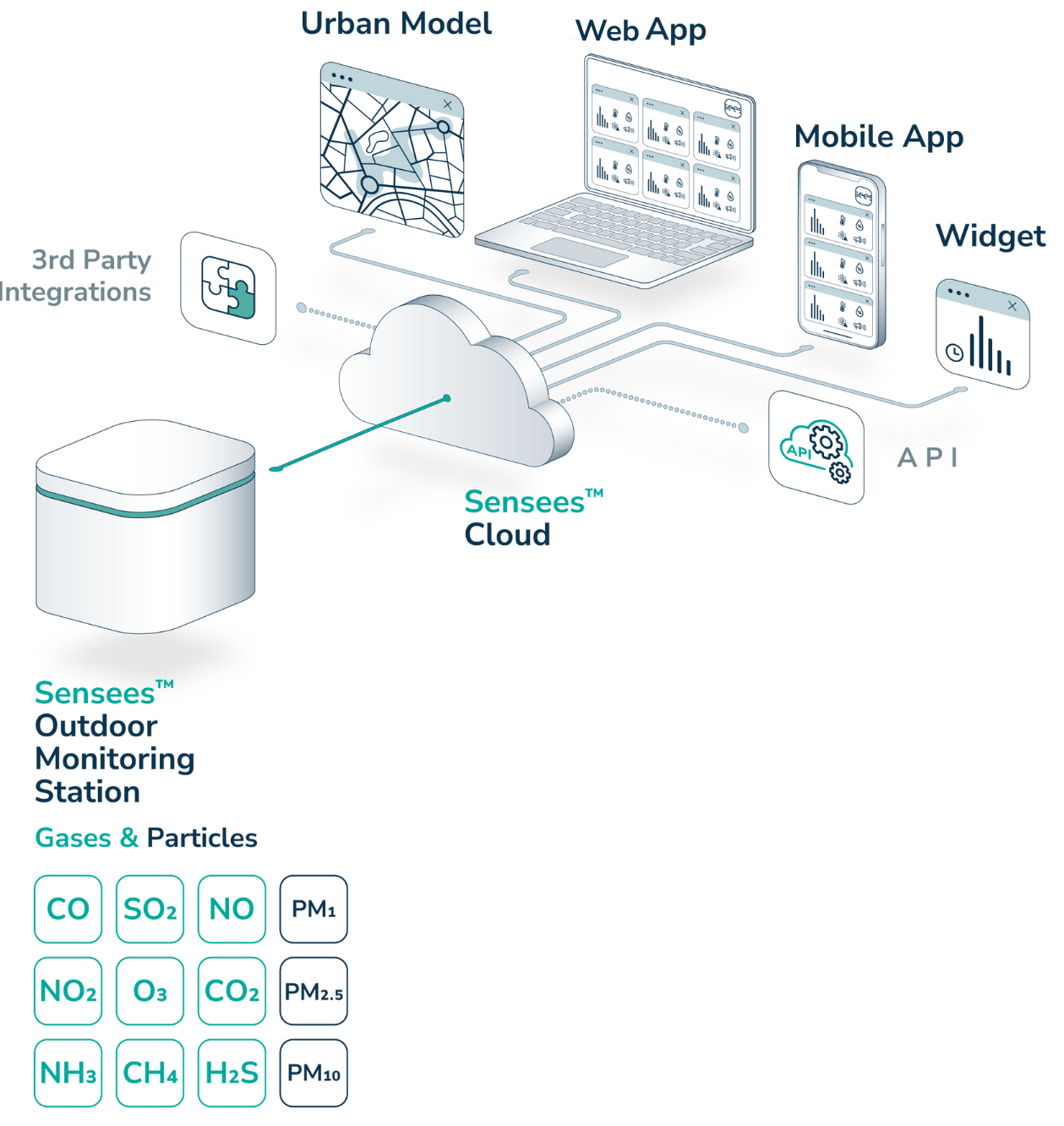Air pollution represents one of the biggest risks to public health worldwide.
Air pollution?
A global concern.
Hundreds of thousands of people in Europe, and more than 7 millions globally, die prematurely every year because they have been exposed to concentrations of pollutants above the levels recommended by the World Health Organisation (WHO).
By reducing air pollution,
communities can reduce
strokes, heart disease, lung
cancer and chronic and acute
respiratory diseases,
including asthma.
• To get relevant data on gases and
particles creating air pollution
• To identify sources and pollution levels
• To be able to define necessary measures
to reduce air pollution.
• To save lives or make them better
Children are more prone to
the adverse effects of air
pollution. There are many
ways how pollution affects
them:
• Low birth weight
• Asthma and reduced lung function
• Risk of respiratory infections
• Upper respiratory infections and otitis
• Allergies, including allergic rhinitis
EEA, European Environment Agency
Act now and establish robust air quality monitoring networks to track pollution levels and identify sources.
These are pollutants you can
keep a close eye on with Sensees
By addressing both gaseous pollutants and particulate matter through comprehensive
strategies, we can significantly improve air quality and protect human health and the
environment.
Pollution subtances to track:
Gases
CO, SO2, NO,
NO2, O3, CO2, CH4, NH3, H2S
Particles
PM1, PM2.5, PM10
Particulate Matter (PM1, PM2.5 and PM10)
Tiny particles suspended in the air, which can penetrate the respiratory system and cause health problems.
Ozone (O3)
A gas that can cause respiratory issues and other health problems at ground level.
Nitrogen Oxide (NO)
Colorless gas and pollutant produced by combustion processes, such as those in vehicles and power plants.
Nitrogen Dioxide (NO2)
A pollutant primarily produced by vehicles and industrial activities, contributing to respiratory problems.
Sulfur Dioxide (SO2)
Emitted from fossil fuel combustion at power plants and other industrial processes, it can cause respiratory problems and other health issues.
Carbon Monoxide (CO)
A colorless, odorless gas produced by burning fossil fuels, which can be deadly in high concentrations.
Carbon Dioxide (CO2)
CO2 sensors measure the concentration of carbon dioxide in the air, which can indicate High levels of CO2 can displace oxygen (O2) and nitrogen (N2), potentially causing health problems.
Methyl (CH4)
A potent greenhouse gas released from livestock, waste management, and natural gas production, CH4 contributes to climate change and can indirectly influence air quality through ozone formation.
Ammonium (NH3)
Emitted from agricultural activities and industrial processes, NH3 can react with other pollutants to form fine particulate matter, impacting air quality and respiratory health.
Hydrogen Sulfide (H2S)
Known for its distinct rotten egg odor, H2S is released from industrial activities and natural sources, posing respiratory risks at elevated concentrations.
Our Partners & Clients

















What our Clients say about us?

Matijana Jergović
M.D., PhD., Primarius, Epidemiologist and Environmental Health Specialist Dr. Andrija Štampar Institute of Public Health
The development of innovative tools for „user friendly“ display of the complex air quality monitoring in spatio-temporal mode with modelling function is extremely important for the air quality health impact assessment, due to the acute but also delayed health outcomes. The development of comprehensive digital infrastructure will make it easier to compare environmental indicators of air quality with health indicators – in order to assess and give recommendations for corrective and preventive measures as accurately as possible.

Goran Škvarč
Deputy CEO for International Cooperation at CARNET
By enabling teachers to have insight into the air quality in the classroom, the AERO system enhances the quality of the teaching process at its core. Teachers get informed at any moment if the air flow in the room is reduced, thereby maintaining an optimal concentration level. This way, CARNET AERO contributes to making schools a pleasant place to stay where every factor affecting the teaching process can be analysed and improved.

Marjana Senčar Srdič
Research and Strategic Development Consultant, A1 Slovenia
At A1 Slovenia, we’re excited to partner with Smartsense, whose Sensees Environment platform has revolutionized our air quality management. Their cutting-edge technology tracks multiple air parameters, empowering citizens and institutions to take proactive steps for better air quality. This collaboration supports our commitment to sustainability and smarter cities.

Goran Matoš
Senior Telecom Infrastructure Architect, Network Transformation Division, A1 Hrvatska d.o.o.
The Energee Meter has revolutionized how we monitor energy consumption at each base station! We were impressed by the quick, simple installation, enabling swift responses to future needs. The cloud-based dashboard provides rich insights for detailed analysis, while the API interface makes it easy to gather data for advanced comparisons with our telecom network. Working with Smart Sense’s talented team is always a pleasure!

Milan Parat
Executive Director of Corporate Security, Privredna banka Zagreb dd
By using Smart Sense solutions for indoor air quality monitoring, we gained valuable and timely information that we used to ensure an optimal microclimate in our offices, aiming to reduce potential health risks associated with working together in enclosed spaces.

Dragan Vulin
Deputy Mayor of Osijek
As a long-time user of Sensees air quality monitoring solutions in the City of Osijek, we are extremely satisfied with the quality of information the system provides. The hardware solution is robust and does not disrupt the urban landscape of our city, while the application allows us to handle all relevant data on air quality, weather conditions, and noise levels—all in real time. By monitoring air quality, we ensure a healthy living environment for our citizens, and we are ready to respond quickly in the event of unforeseen environmental disruptions.

Tomislav Babić
Headmaster - Lucijan Vranjanin High School
The motivation for installing Sensees Indoor sensors was to monitor classroom conditions during lessons and state exams in early summer. With long-standing issues of high temperatures in classrooms, I wanted to track temperature and CO2 levels to find optimal solutions. The easy-to-use software provides daily insights, helping detect issues and improve learning conditions, leading to better student focus, results, and energy savings.

Andreas Economides
The Cyprus Telecommunications Authority (CYTA) Partnerships and New Ventures Coordinator Vertical Markets
It was a pleasure working with Smart Sense on the Nicosia Smart City project providing high quality environmental sensors. Their dedication to quality, attention to detail, and exceptional collaboration made the entire process seamless from start to finish. They consistently met project deadlines, provided expert insights, and maintained clear and open communication throughout. The level of professionalism demonstrated was remarkable, and their innovative approach helped us overcome challenges and deliver a successful outcome. We look forward to future collaborations and highly recommend their services for similar projects.

Željko Turk
Mayor of Zaprešić
We always strive to provide our citizens with technology that truly makes a difference and elevates the quality of life. That’s exactly why we chose Smart Sense. We are extremely pleased with the installation of Sensees Indoor sensors in all our schools and kindergartens, as well as Sensees Outdoor stations for monitoring outdoor air quality. These sensors provide us with valuable insights into air quality, helping us ensure healthier environment for our children and fellow citizens. The data we receive allows us to make timely, informed decisions. We are very satisfied with the positive impact these projects have on our community
Case studies
Learn how others have improved their lives and work productivity by implementing Environmental monitoring systems in their cities, companies or homes.






